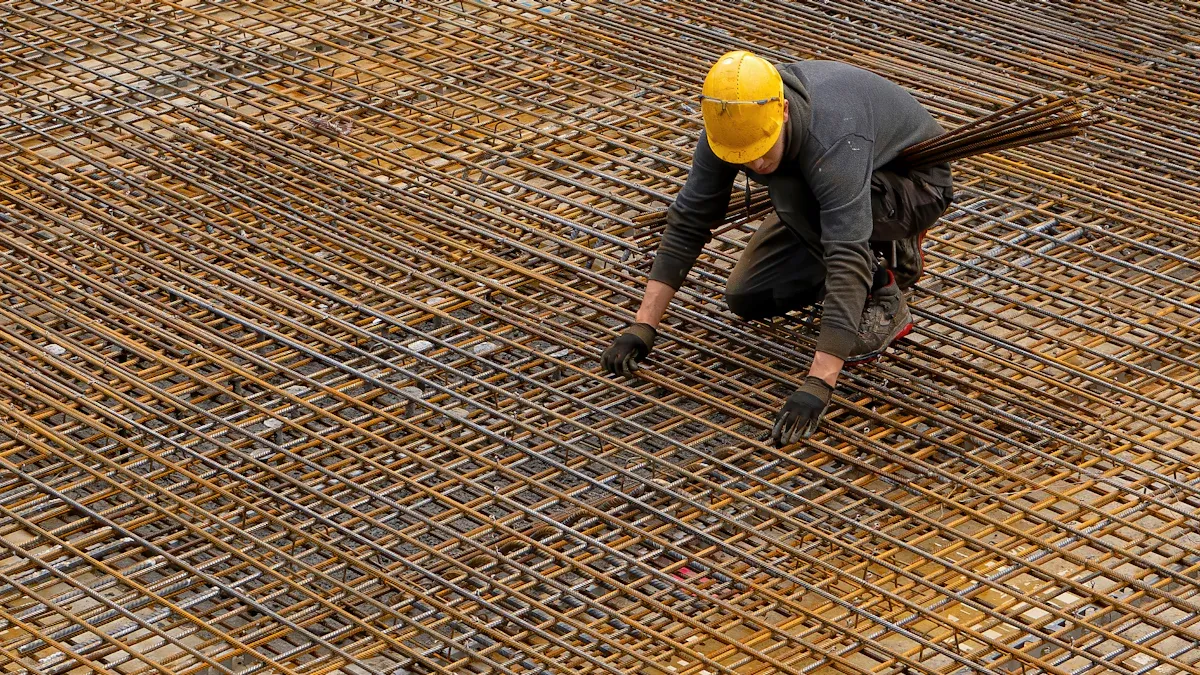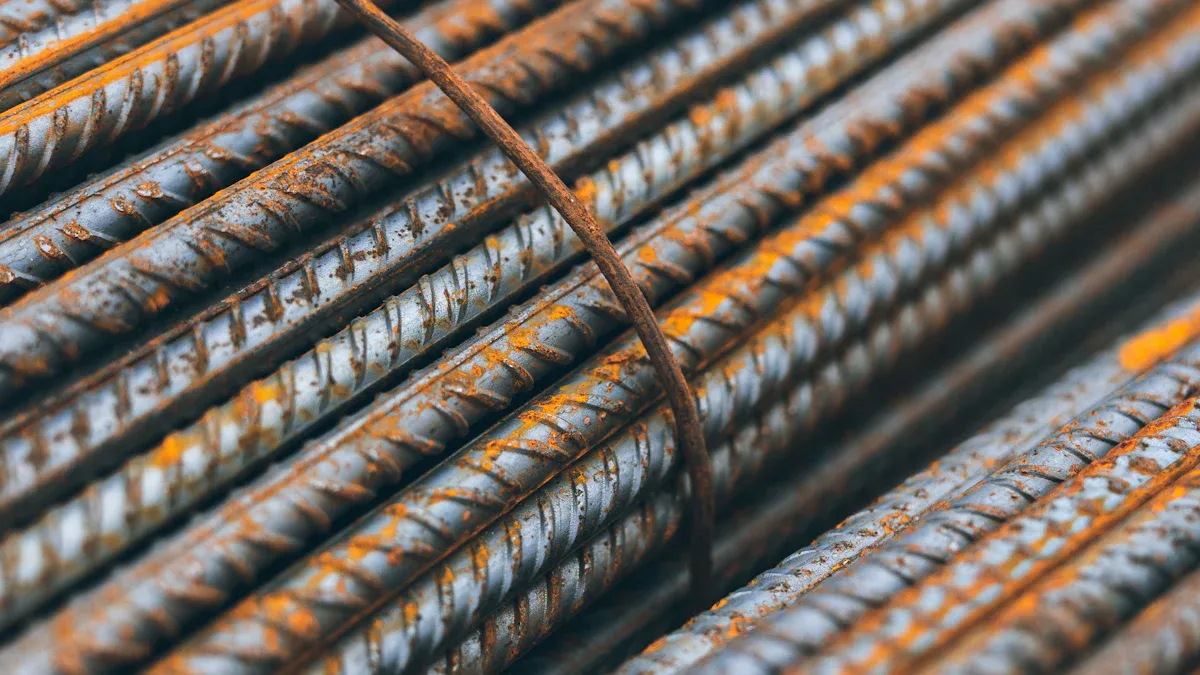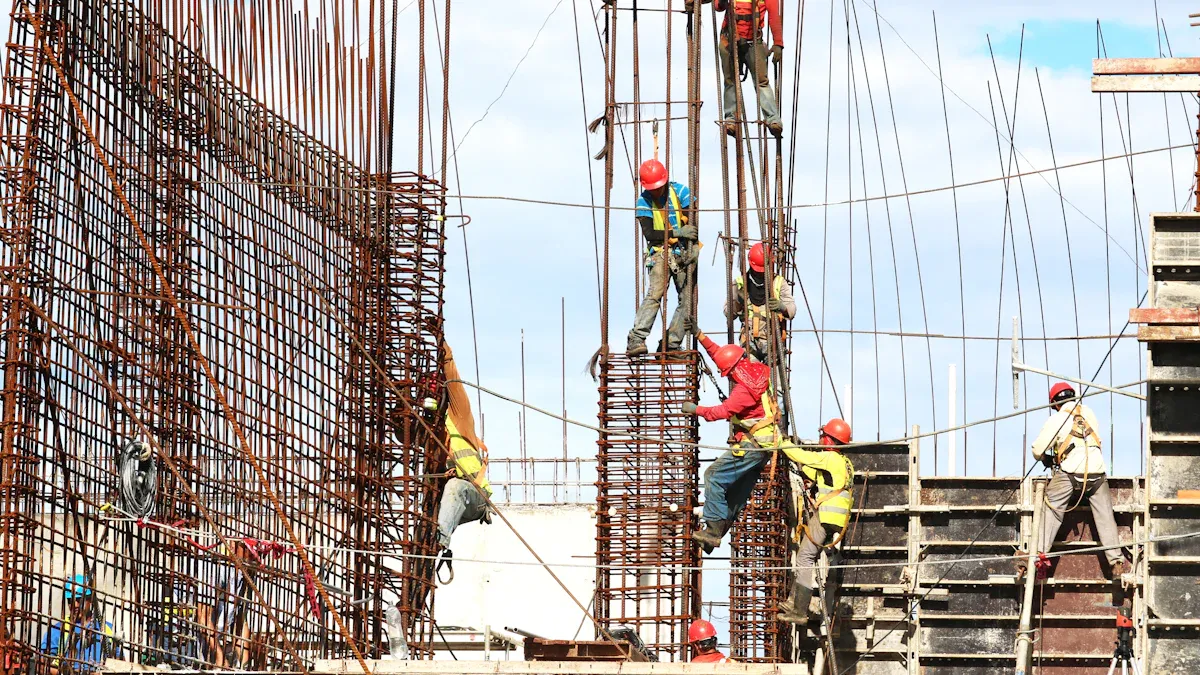
What is a Steel Reinforcing Bar
Share
Table Of Content
Table Of Content

A steel reinforcing bar, often called rebar, is a metal bar designed to boost the tensile strength of concrete. While concrete excels at handling compression, it struggles under tension. Rebar bridges this gap by providing the necessary tensile strength, ensuring concrete structures can withstand various forces without cracking or failing.
You might wonder how reliable these bars are. Studies show that modern steel reinforcing bars exceed ASTM A615 standards, with tensile strengths ranging from 673.8 MPa to 701.1 MPa. This reliability makes them indispensable in construction, where durability and safety are paramount. From skyscrapers to bridges, rebar plays a vital role in shaping the world around you.
Key Takeaways
- Steel rebar, or reinforcing bars, make concrete stronger against pulling forces.
- Good quality steel bars can help concrete last much longer. Stainless steel bars can last over 100 years.
- Rebar spreads weight evenly in concrete, lowering stress and stopping breaks.
- New rebar tech, like 3D printing and special coatings, makes it stronger and better for the environment.
- Recycling old steel to make rebar helps the planet and is a green choice for building.
Purpose and Importance of Steel Reinforcing Bars
Why Concrete Needs Reinforcement
Concrete's Strengths and Weaknesses
Concrete is one of the most widely used materials in construction. It excels in handling compressive forces, making it ideal for supporting heavy loads. However, concrete has a significant weakness—it lacks tensile strength. This means it cannot resist forces that pull or stretch it, leading to cracks and structural failures over time. Without reinforcement, concrete structures would struggle to withstand dynamic forces like wind, earthquakes, or heavy traffic.
How Steel Reinforcing Bars Address Concrete's Weaknesses
Steel reinforcing bars provide the solution to concrete's limitations. These bars enhance the tensile strength of concrete, allowing it to handle both compressive and tensile forces effectively. The combination of concrete and steel creates a composite material that is strong, durable, and versatile. For example, studies show that using solid stainless steel reinforcing bars can more than double the lifespan of bridge decks compared to traditional carbon steel. While stainless steel may increase initial costs by 12%, its corrosion resistance reduces maintenance expenses and extends the structure's life significantly.
Role of Steel Reinforcing Bars in Structural Integrity
Enhancing Tensile Strength
Steel reinforcing bars play a critical role in improving the tensile strength of concrete structures. Steel's mechanical properties, such as high yield strength and tensile strength, ensure that reinforced concrete can withstand stretching and pulling forces. This makes it suitable for applications like bridges, skyscrapers, and industrial buildings. In some regions, however, substandard steel bars have been a concern. For instance, studies in Cameroon revealed that over half of the steel bars tested had yield stresses below the standard 400 MPa, posing risks to structural safety. High-quality steel reinforcing bars are essential to avoid such issues and ensure the reliability of construction projects.
Preventing Cracks and Failures
Cracks in concrete can compromise the safety and durability of a structure. Steel reinforcing bars help distribute loads evenly across the concrete, reducing stress concentrations that could lead to cracks. Their ability to bond tightly with concrete ensures that the two materials work together to resist external forces. Additionally, corrosion-resistant steel bars, like stainless steel, minimize the risk of cracks caused by rust expansion. This not only prevents structural failures but also reduces long-term repair costs.
Properties and Functionality of Steel Reinforcing Bars
Key Material Properties
Tensile Strength
Steel reinforcing bars possess exceptional tensile strength, making them ideal for reinforcing concrete. Tensile strength ensures that the bars can resist stretching forces without breaking. For example, tensile strength values for steel reinforcing bars range from 673.8 MPa to 701.1 MPa, depending on the material lot. This strength allows structures to endure heavy loads and dynamic forces like earthquakes or wind.
Ductility and Flexibility
Ductility refers to the ability of steel to deform under stress without breaking. This property ensures that steel reinforcing bars can bend and adapt during construction without losing their structural integrity. Flexibility also helps the bars absorb energy during events like seismic activity, reducing the risk of sudden failure. Bend tests confirm the ductility of steel bars by bending them to specific angles and checking for cracks or fractures.
Corrosion Resistance
Corrosion resistance is crucial for the longevity of steel reinforcing bars. Elements like carbon, manganese, and silicon in the steel's composition enhance its ability to resist rust. Stainless steel reinforcing bars, for instance, offer superior corrosion resistance, making them suitable for structures exposed to moisture or harsh environments.
| Property | Description |
|---|---|
| Elastic properties | Modulus of all steel reinforcement is 29,000,000 psi, simplifying design processes. |
| Elongation under load | Provides well-defined cracks during overload, warning occupants of potential structural issues. |
| Thermal properties | Modulus of thermal expansion is similar to concrete, preventing additional stresses. |
| Strength retention | Steel withstands high temperatures before losing strength, aiding in rehabilitation post-fire. |
How Steel Reinforcing Bars Work in Concrete
Bonding Between Steel and Concrete
Steel reinforcing bars bond tightly with concrete, creating a composite material that works as a single unit. This bond ensures that the steel and concrete share the load, improving the structure's overall strength. Tensile tests validate this bonding by measuring the force required to pull the steel out of the concrete. Proper bonding also prevents slippage, ensuring the structure remains stable under stress.
Load Distribution and Stress Management
Steel reinforcing bars help distribute loads evenly across a concrete structure. This reduces stress concentrations that could lead to cracks or failures. Flexure tests assess how well the bars manage bending loads, ensuring the structure can handle various forces. The uniform properties of steel in all directions further enhance its performance, providing consistent support throughout the structure.
Manufacturing Process of Steel Reinforcing Bars

Raw Materials and Initial Processing
Steel Production and Recycling
The production of a steel reinforcing bar begins with sourcing raw materials. Scrap steel serves as the primary input, melted in electric induction furnaces. This process not only reduces waste but also supports sustainability by recycling existing materials. Continuous casting then transforms the molten steel into billets, which are the foundational blocks for rebar production. These billets undergo reheating to 1150 ℃, preparing them for the next stage of shaping and forming.
| Evidence Type | Description |
|---|---|
| Raw Material Selection | Scrap steel is collected through individual brokers due to the lack of organized scrap dealers. |
| Initial Processing Techniques | Electric induction furnaces melt scrap, followed by continuous casting for billet formation. |
| Production Options | Rebar can be made from locally produced billets, imported billets, or direct hot billet transfer. |
Shaping and Forming Steel Reinforcing Bars
Hot Rolling Process
Hot rolling is the primary method for shaping steel reinforcing bars. Reheated billets pass through a series of rollers, reducing their size and forming the desired shape. This process ensures uniformity and strength in the final product. Thermomechanical treatment (TMT) follows, where the bars are quenched to enhance their mechanical properties. TMT improves tensile strength and ductility, making the bars suitable for demanding construction applications.
| Process Step | Description |
|---|---|
| Induction Furnace | Melts scrap materials to produce steel. |
| Continuous Casting | Forms billets from molten steel. |
| Billet Reheating | Heats billets to a temperature of 1150 ℃ before rolling. |
| Roll Forming | Shapes the reheated billets into reinforcing bars through a series of reduction strands. |
| Thermomechanical Treatment (TMT) | Improves mechanical properties of the rebar through quenching after rolling. |
Surface Treatments for Better Bonding
Surface treatments enhance the bond between steel reinforcing bars and concrete. Ribbed or deformed surfaces increase friction, ensuring the bars stay firmly embedded within the concrete. Some bars also receive anti-corrosion coatings, which protect them in environments prone to moisture or chemical exposure. These treatments extend the lifespan of the bars and improve the durability of the structures they reinforce.
Quality Control and Standards
Testing for Strength and Durability
Quality control ensures that steel reinforcing bars meet industry standards. Various tests validate their strength, flexibility, and resistance to environmental factors. Bend tests check ductility by bending the bars to specific angles, while tensile tests measure their ability to withstand pulling forces. Corrosion testing evaluates performance in harsh conditions, and non-destructive testing (NDT) detects internal defects without damaging the material.
| Test Type | Purpose |
|---|---|
| Bend Testing | Assesses ductility and flexibility by bending the steel to specific angles and checking for cracks. |
| Chemical Composition Analysis | Determines the percentage of various elements within the steel to ensure it meets specifications. |
| Corrosion Testing | Evaluates resistance to corrosive environments, crucial for structures in harsh conditions. |
| Non-Destructive Testing (NDT) | Techniques like ultrasonic testing detect internal defects without damaging the steel. |
| Tensile Test | Examines how well a steel bar can handle pulling forces, revealing properties like UTS and Yield Strength. |
Testing protocols follow global standards such as ASTM A615 and ISO 6935-2. These standards ensure that steel reinforcing bars deliver consistent performance, meeting the demands of modern construction.
Applications and Benefits of Steel Reinforcing Bars

Common Applications in Construction
Residential and Commercial Buildings
You encounter steel reinforcing bars in almost every modern building. They provide the tensile strength needed to support walls, floors, and foundations. In high-rise buildings, these bars ensure the structure can withstand wind forces and seismic activity. Their flexibility allows architects to design innovative spaces without compromising safety.
Bridges and Infrastructure
Steel reinforcing bars play a vital role in bridges and other infrastructure projects. For example, the Alexander Hamilton Bridge used stainless steel reinforcing bars to reduce the need for additional reinforcement. This decision not only cut costs but also shortened construction time by six months. Similarly, the Undercliff Avenue Bridge project reduced deck thickness, eliminating the need for an extra girder and saving money. These examples highlight how steel reinforcing bars enhance both efficiency and durability in large-scale projects.
Industrial Structures
Industrial facilities demand materials that can handle extreme conditions. Steel reinforcing bars meet this need by offering high tensile strength and durability. A study comparing two lots of Grade 60 steel bars showed that both exceeded ASTM A615 standards. This reliability ensures industrial structures can support heavy machinery and withstand harsh environments without failure.
Benefits of Using Steel Reinforcing Bars
Increased Structural Longevity
Steel reinforcing bars significantly extend the lifespan of concrete structures. Recent studies show that using stainless steel bars can more than double the lifespan of bridge decks, often exceeding 75 years. Some structures even last over a century. While stainless steel increases initial costs by about 12%, its durability reduces maintenance expenses, making it a smart long-term investment.
Cost-Effectiveness in the Long Term
You save money over time by using steel reinforcing bars. Projects like the Major Deegan Expressway Viaduct demonstrate this. By combining stainless steel bars with lightweight concrete, engineers eliminated the need for 16 new foundations. This approach reduced costs associated with seismic upgrades, proving that steel reinforcing bars offer both strength and economic advantages.
Versatility in Design and Construction
Steel reinforcing bars adapt to a wide range of construction needs. Their ductility allows them to bend into various shapes, supporting creative architectural designs. Whether you’re building a skyscraper, a bridge, or an industrial facility, these bars provide the flexibility and strength required for any project.
History of Steel Reinforcing Bars
Early Use of Reinforcement in Construction
Ancient Techniques (e.g., bamboo and iron rods)
The concept of reinforcing construction materials dates back thousands of years. Early builders used natural materials like bamboo and wooden stakes to strengthen structures. These primitive methods laid the foundation for modern reinforcement techniques. Over time, iron rods replaced wood, offering greater strength and durability.
Rebar’s story began with humble roots, evolving from wooden stakes to iron rods, which became essential during the industrial era. This evolution reflects a balance of strength, cost, and durability, showcasing how historical techniques have shaped modern construction practices.
The transition from natural materials to iron marked a turning point in construction. It allowed for the creation of more robust and longer-lasting structures, paving the way for the development of steel reinforcing bars.
Development of Modern Steel Reinforcing Bars
Ernest L. Ransome's Patent for Twisted Iron Rebar (1884)
In 1884, Ernest L. Ransome revolutionized construction by patenting twisted iron rebar. His innovation improved the bond between concrete and reinforcement, making structures more resilient. This advancement addressed the limitations of earlier materials, such as mild steel, which lacked sufficient yield strength and corrosion resistance.
Introduction of Lugged Bars and Evolution of Standards
The introduction of lugged bars further enhanced the performance of steel reinforcement. These bars featured surface deformations that improved their grip within concrete, reducing the risk of slippage. Over the years, industry standards evolved to ensure consistent quality and performance. For example:
- Early materials included wooden stakes and twigs, evolving to iron rods, which marked a significant advancement in construction techniques.
- Mild steel became a common choice but faced limitations due to lower yield strength and susceptibility to corrosion.
- The development of TMT bars represented a major innovation, offering higher strength and durability, transforming construction practices.
| Year | Event | Description |
|---|---|---|
| 1850 | Development of rebar concrete | Technique developed in France, credited to various individuals including Joseph Monier. |
| 1867 | Patent granted | Monier received a patent for his reinforced concrete technique, marking a significant milestone in construction history. |
Steel Reinforcing Bars in Contemporary Construction
Innovations and Sustainability Efforts
Modern advancements in steel reinforcing bars focus on sustainability and performance. Innovations like 3D printing allow for customized designs, reducing waste and improving efficiency. Nanotechnology coatings enhance durability and corrosion resistance, extending the lifespan of structures.
- 3D Printing of Rebar: Enables the creation of complex, customized designs, reducing waste and improving construction efficiency.
- Nanotechnology Coatings: Uses nanoparticles, such as graphene, to enhance durability and corrosion resistance.
- CFRP Rebar: Made from carbon fiber, this type of rebar is lighter, stronger, and non-corrosive, making it ideal for harsh environments.
| Innovation Type | Description |
|---|---|
| 3D Printing | Enhances speed and efficiency in construction by allowing for customized rebar production with high precision, resulting in stronger structures. |
| Nanotechnology | Utilizes tiny particles in coatings to improve durability, corrosion resistance, and lifespan of rebar. |
These advancements demonstrate the ongoing evolution of steel reinforcing bars, ensuring they meet the demands of modern construction while promoting sustainability.
Steel reinforcing bars have revolutionized modern construction by enhancing the strength, durability, and versatility of concrete. They allow structures to endure immense forces while maintaining their integrity over time. For example, stainless steel reinforcing bars can last over 100 years in northern climates, doubling the lifespan of bridge decks. Although their initial cost is higher, the long-term savings and durability make them a smart investment. From ancient techniques to cutting-edge innovations, rebar continues to evolve, ensuring safer and more sustainable construction for future generations.
The journey of steel reinforcing bars reflects progress, blending historical ingenuity with modern advancements to shape the world you live in.
FAQ
What is the purpose of steel reinforcing bars in construction?
Steel reinforcing bars strengthen concrete by providing tensile support. Concrete handles compression well but struggles with tension. Rebar bridges this gap, ensuring structures resist forces like stretching or pulling, which prevents cracks and failures.
How do steel reinforcing bars bond with concrete?
Steel bonds with concrete through friction and adhesion. Deformed or ribbed surfaces on rebar improve grip, ensuring the materials work together as a single unit. This bond distributes loads evenly, enhancing structural stability.
Are there different types of steel reinforcing bars?
Yes, you can find various types, including carbon steel, stainless steel, and epoxy-coated bars. Each type suits specific environments. For example, stainless steel resists corrosion, making it ideal for coastal or humid areas.
How long do structures reinforced with steel bars last?
Structures reinforced with high-quality steel bars can last over 75 years. Stainless steel bars often double the lifespan of concrete structures, especially in harsh climates, by resisting corrosion and reducing maintenance needs.
Can steel reinforcing bars be recycled?
Yes, steel reinforcing bars are highly recyclable. Scrap steel serves as the primary raw material for rebar production. Recycling reduces waste and supports sustainable construction practices, making it an eco-friendly choice.
Tip: Always choose the right type of rebar for your project to maximize durability and cost-effectiveness.

1 comment
Перед началом работы стоит ознакомиться с возможностями хрумера, чтобы избежать ошибок.